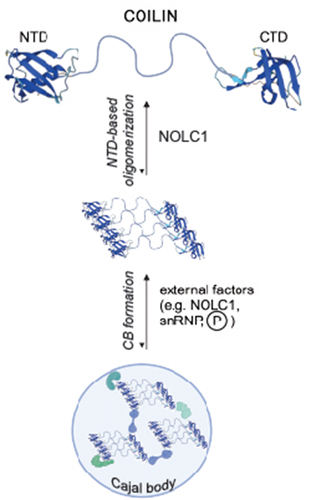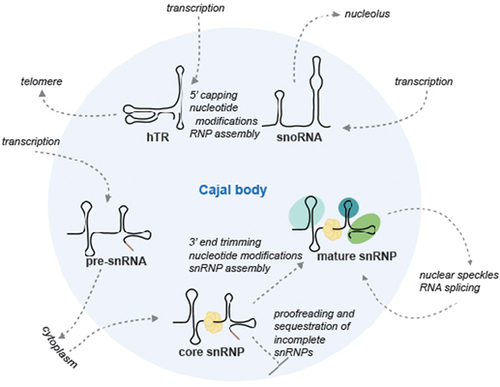Figures & data
Figure 1. Formation of the Cajal body. A coilin-centered view of CB formation. Coilin is the scaffolding protein of CBs, which contain two conserved domains at the N and C termini, termed NTD and CTD. A structure of these domains was approximated by Alphafold (alphafold.Ebi.ac.uk) using human coilin as input. In the first step, coilin self-interacts via the NTD to form oligomers, which are the basic building blocks of CBs. This step is likely spontaneous, but can be modulated by factors that interact with NTD (e.g. NOLC1). In the second step, coilin oligomers condense to form a microscopically visible structure. This step is regulated by several extrinsic factors, including protein kinases and phosphatases that phosphorylate/dephosphorylate coilin and protein interaction partners, such as NOLC1 and snRNPs. The image was created with BioRender.com.

Figure 2. Function of Cajal bodies. The metabolism of several RNPs is closely associated with CBs. snRNA and some snoRNA genes (U3) are found in the vicinity of CBs. Newly transcribed pre-snRNAs pass through CBs on their way to the cytoplasm where they acquire the Sm ring (yellow bolls). After returning from the cytoplasm, core snRNPs (snRNA+Sm proteins) visit CBs again to complete their biogenesis (trimming of the 3’ extension, ribose methylation and pseudouridylation, and addition of snRNP-specific proteins). Mature snRNPs leave the CB to localize to nuclear speckles and catalyze RNA splicing. Defective and incomplete snRNPs are sequestered in CBs by an unknown mechanism. Human telomerase RNA (hTR) and snoRNAs pass through CBs during their biogenesis to acquire 2,2,7-trimethylation at the 5’ end (hTR, U3 and U8 snRNAs) and possibly assemble here into functional RNPs before reaching their final destination. The image was created with BioRender.com.

Data availability statement
There are no primary data associated with this manuscript.
